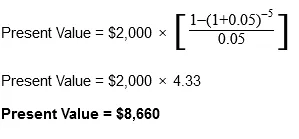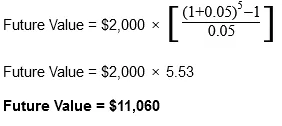Annuity Factor
The annuity factor definition is the use of a financial method that shows the value, present or future, of an amount when it is multiplied by a periodic amount. The calculation of an annuity factor requires the number of years involved, or the periodic amount, and the percentage rate applicable. The most often used for annuity factors are investments with either or both an annual payment or return. Typical examples of annuity factors being applied are savings accounts, certain types of insurances, or retirement savings plans.
The annuity factor meaning is a particular type of accumulating discount factor used to determine the present or future value of annuities, as well as equated installments. Another name for annuity factors is the annuity formula, and we’ll get into that momentarily.
The Present Value Annuity Factor
The present value annuity factor allows you to determine the amount of money required at the present time in order to result in a future series of payments assuming a fixed interest rate is applied.
In order to reach the present value annuity factor, a formula is used that discounts a future value amount to the present value amount through the use of the applicable interest rate. The period of time during which the investment will last is also taken into account to reach the correct value.
The Present Value Annuity Formula

With:
C=cash flow per period
i = interest rate
n = number of payments
The Future Value Annuity Factor
The future value annuity factor gives access to the final return value of a series of regular investments taking into account their worth at a future time, usually at the end of the investing period, assuming that a fixed interest rate is applied.
To reach the future value annuity factor, the formula above is slightly altered in order to add the values collected over the years by also accounting for the set interest rate.
The Future Value Annuity Factor

With:
C=cash flow per period
i = interest rate
n = number of payments
Applying the Annuity Factor formulas:
Considering an investment with an annual $2,000 payment over the course of five years at an interest rate of 5%, let’s see what the present and future value would be.


The previous formulas can help you determine the present and future values of ordinary annuities. While the math might seem complicated, there are financial calculators online that can help you out with the correct inputs and data.
Popular Real Estate Terms
model depicting on paper what a structure physically looks like. The dimensions are draw on a proportionate basis to the real thing. An example is a scale of an existing or proposed office ...
Index of the costs to construct residential properties. ...
Unincorporated combination (roll-up) of limited partnerships in a real estate together as a group. It is usually more comprehensive, financially sound, and marketable than individual ...
Method of selling and obtains possession, but the seller retains the title. ...
Number of times a given amount of capital assets turn over to generate sales over a given period of time. ...
Building with large unpartitioned floors areas often used for storage. ...
Partial fulfillment. Pro tanto is normally used in relation to the partial satisfaction of a claim. For example, a pro tanto settlement in an eminent domain action will not prejudice any ...
A municipal or county local government board that resolves zoning disputes. ...
percentage of land that may be used productively to the total square footage of the land. For example, if total square footage is 40,000 but only 30,000 square feet may be built upon ...
Have a question or comment?
We're here to help.